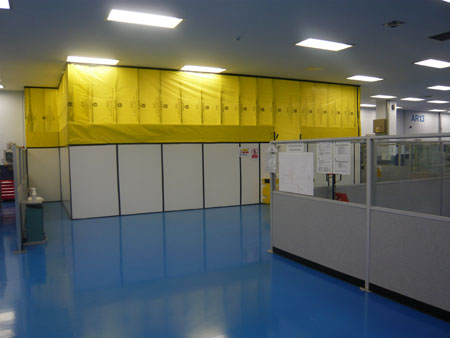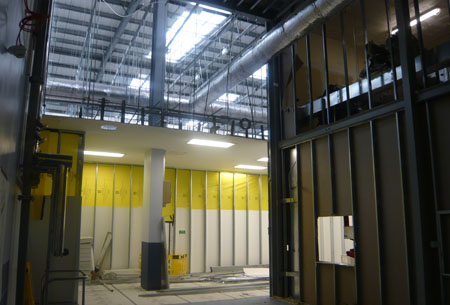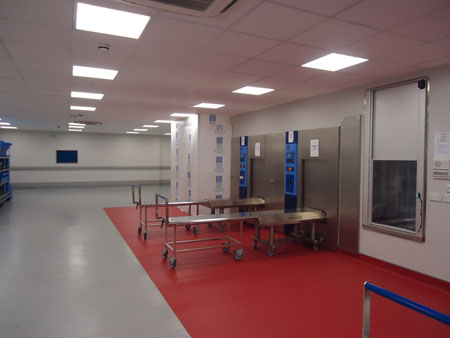Projects in high care environments require specialist skills to minimise contamination risks and work disruption. Adam Bell, managing director of Building Projects (UK) outlines best practice and new approaches.
Over the past decade there has been a definite rise in demand for skills and experience of working with high care environments. While construction is a necessity, it is not always possible or practical to close down areas or halt production in a high care (mission critical) environment; it has to be business as usual for clients.
Whether from the public or private sector, construction companies have to understand the client’s objectives and identify what the impact of the work could be on their facilities, users and stakeholders.
There are often additional risks or implications for high care environments, particularly in the healthcare sector. One of its major concerns is minimising the potential risk of Hospital Acquired Infections (HAIs) and protecting patients and staff during a construction project.
Construction can be a major contributor to HAIs and the same strict cross-contamination controls used within environments such as the pharmaceutical industry are transferable to this sector. And with changes in NHS directives resulting in stricter control procedures within health centres, the same protection and risk management needs to be transferred to these types of environment.
It is key that building companies have experience of working in different types of high care environments so that skills and techniques developed to increase effective-ness and to minimise contamination potential in comparable sectors can be shared.
Due care and attention demanded in cleanroom facilities should be applied to all high care environments, including hospitals, GP surgeries, care homes, food processing and packaging plants, as well as research and development laboratories.
Building Projects (UK) has worked in the pharmaceutical industry for many years, designing, building, converting and refurbishing high specification, uni-directional and non-unidirectional cleanroom facilities. The company is often brought in by the main contractor because of its specialist skills and knowledge of working in an aseptic controlled environment.
Cross-contamination risk
Advancing technologies, new materials and shifting health and safety regulations all contribute to the challenge of any building project in a high care environment, but the principles remain the same. Nursing and care homes are extensions of the healthcare system and the people in these environments are just as at risk and vulnerable as patients in a hospital. Measures should always be put in place to reduce risk and infection contamination during a construction project in such facilities.
Those working in the food processing and packaging industry have to manage risks regarding the potential for cross-contamination in products because in these sectors there is the potential to damage a brand, with disastrous financial consequences.
All high care contracts have guidelines and state the procedures that are required in terms of construction control. However, Building Projects (UK)’s own internal practices are often of a higher standard than those laid down. The company recently published a company charter that demonstrates just how seriously it regards contamination control and its commitment to clients.

Figure 3: Dust-proof, fully sealed screens provide a partition between the working areas and the construction
The Control Charter sets out the methods adopted to prevent cross-contamination and the construction controls and procedures used. It includes detailed, project-specific risk assessments, creation of working zones using robust, dust-proof barriers capable of maintaining the necessary air pressures, construction of temporary airlocks with zipped double doors for access and egress of materials and personnel, and the use of ‘tacky-matting’ as dust traps in all access points of the working area. The Charter is in addition to the standard health and safety regulations adhered to on a construction site and its quality management systems in line with ISO 9001, ISO 14001 and OHSAS 18001.
Daily inspections by the company’s own staff ensure the integrity of its temporary screening and certification of the working area, including a contamination inspection that is carried out prior to handover.
The company also uses careful planning to minimise disruption to daily activities as the consequences can be devastating. Millions of pounds could be lost through the cross contamination in production areas and the consquences of spreading infections in healthcare facilities are far too great for any company to ignore. But careful planning and open communication goes a long way towards a project being successfully delivered and meeting all the client’s requirements.
Hospital expansion
The Control Charter was used to great effect when the company was contracted to create additional bedrooms at Hereford County Hospital, part of the Wye Valley NHS Trust. The company was tasked with creating 15 bedrooms while ensuring the surrounding wards remained fully operational.
In addition to its own Control Charter, the company adhered to Hereford County Hospital’s in-house strict infection control requirements; weekly meetings took place to discuss the ways in which the company planned to minimise cross-contamination. These measures included: installation of flame retardant, fully-sealed, pressurised, temporary partitions to segregate the building works from the main functioning areas of the hospital; creating temporary double sealed airlocks at the entrances and exits of the construction areas; the donning of overshoes; and tacky mats utilised at all access points of the working areas. Hereford Hospital was so impressed with the contamination prevention controls, that it showcased them to other contractors to demonstrate best practice and to set the standard for future works.

Figure 4: The project gets underway behind the screens
To maintain a sense of normality, Building Project (UK) operatives wore regular clothing in the hospital corridors, and then changed into high visibility jackets, safety helmets and work boots once behind the partitioned areas and out of sight of patients. Even waste materials from the works were covered so they were not recognisable to further minimise the impact of the building works on staff and patients.
This project created an additional challenge when the company had to work around an isolated area being used to control an outbreak of the stomach bug Norovirus. Only the team’s implementation of enhanced management controls and procedures allowed the hospital to work to its safest maximum capacity.
The company’s attention to detail didn’t go unrecognised. Its procedures were awarded a ‘Going the Extra Mile Award’ for Health and Safety procedures by Wye Valley NHS Trust. Figure 1 shows Hereford Hospital and the dustproof acoustic segregation within working hospital wards over three floors to create 15 much needed extra beds.
New packaging area
Another example of a recent high care project is that carried out for Teva UK, one of the largest pharmaceutical companies in the UK. Figure 2 shows how Building Projects (UK) created a new packaging area within a live pharmaceutical production facility. Behind its dust-proof, fully sealed screens, heavy demolition was taking place and a temporary dust extraction system was used. The screens also allowed for fire escapes.
The company has also completed work for the specialist healthcare services provider Synergy Healthcare. Figure 5 shows the nearly completed sterilisation machinery for Synergy Healthcare, Knowsley, with just the dust-proof segregation still in place.

Figure 5: The sterilisation machinery for Synergy Healthcare, Knowsley, on near completion of the build with just the dust-proof segregation still in place
Building Projects (UK) continues to invest heavily in research and development to make sure it understands the latest cleanroom technologies and to keep it at the forefront of the controlled environment industry. For example, it recently started using Hilti’s dust removal systems incorporating HEPA vacuums that are integrated into the power tools and equipment for drilling, chiselling and sawing. It is a much more efficient system and helps prevent dust from entering the working environment.
Dust is a constant problem for a construction project in a high care environment – simply slitting cable trays into concrete can produce 15kg of dust in just one hour, which can create a lot of potential contamination. So the new dust removal system will stop 99% of the dust becoming airborne.
Adam Bell is a member of a national health technology business support organisation, Medilink, which is dedicated to the growth and development of health, technology and related life science industries. He is also an active board member of a special interest group responsible for infection control, enabling him to keep abreast of industry issues and to help the company respond effectively to client demands.




